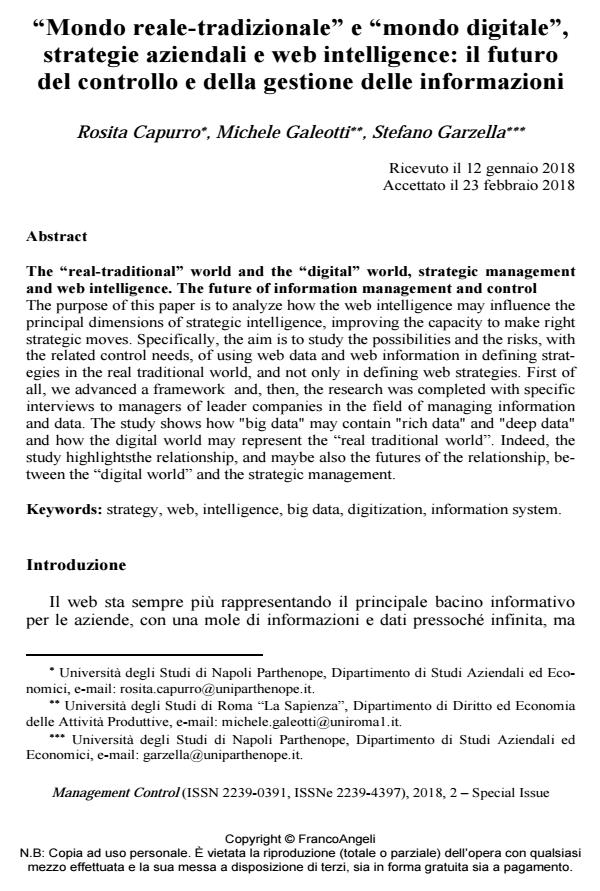"Mondo reale-tradizionale" e "mondo digitale", strategie aziendali e web intelligence: il futuro del controllo e della gestione delle informazioni
Titolo Rivista MANAGEMENT CONTROL
Autori/Curatori Rosita Capurro, Michele Galeotti, Stefano Garzella
Anno di pubblicazione 2018 Fascicolo 2018/2 Suppl.
Lingua Italiano Numero pagine 29 P. 83-111 Dimensione file 444 KB
DOI 10.3280/MACO2018-SU2005
Il DOI è il codice a barre della proprietà intellettuale: per saperne di più
clicca qui
Qui sotto puoi vedere in anteprima la prima pagina di questo articolo.
Se questo articolo ti interessa, lo puoi acquistare (e scaricare in formato pdf) seguendo le facili indicazioni per acquistare il download credit. Acquista Download Credits per scaricare questo Articolo in formato PDF

FrancoAngeli è membro della Publishers International Linking Association, Inc (PILA)associazione indipendente e non profit per facilitare (attraverso i servizi tecnologici implementati da CrossRef.org) l’accesso degli studiosi ai contenuti digitali nelle pubblicazioni professionali e scientifiche
The purpose of this paper is to analyze how the web intelligence may influence the principal dimensions of strategic intelligence, improving the capacity to make right strategic moves. Specifically, the aim is to study the possibilities and the risks, with the related control needs, of using web data and web information in defining strat-egies in the real traditional world, and not only in defining web strategies. First of all, we advanced a framework and, then, the research was completed with specific interviews to managers of leader companies in the field of managing information and data. The study shows how "big data" may contain "rich data" and "deep data" and how the digital world may represent the "real traditional world". Indeed, the study highlightsthe relationship, and maybe also the futures of the relationship, between the "digital world" and the strategic management.
Parole chiave:Strategy, web, intelligence, big data, digitization, information system
- Gestione integrata dei dati e performance aziendali Antonella Paolini, in MANAGEMENT CONTROL 2/2022 pp.5
DOI: 10.3280/MACO2022-002001 - Management Control System in Smart and Sustainable Firms Domenica Lavorato, pp.137 (ISBN:978-3-031-81435-8)
- La Business Intelligence e la Business Analytics nell'era dei Big Data: una analisi della letteratura Arianna Petrosino, Daniela Mancini, Stefano Garzella, Rita Lamboglia, in MANAGEMENT CONTROL 3/2018 pp.31
DOI: 10.3280/MACO2018-003003 - Integrated reporting o disintegrated reporting? Un'analisi teorica per una proposta empirica di reale integrazione Paolo Esposito, Stefano Garzella, Domenica Lavorato, in MANAGEMENT CONTROL 3/2024 pp.87
DOI: 10.3280/MACO2024-003005 - Management Control System in Smart and Sustainable Firms Domenica Lavorato, pp.1 (ISBN:978-3-031-81435-8)
Rosita Capurro, Michele Galeotti, Stefano Garzella, "Mondo reale-tradizionale" e "mondo digitale", strategie aziendali e web intelligence: il futuro del controllo e della gestione delle informazioni in "MANAGEMENT CONTROL" 2 Suppl./2018, pp 83-111, DOI: 10.3280/MACO2018-SU2005